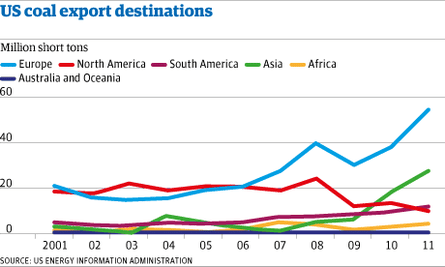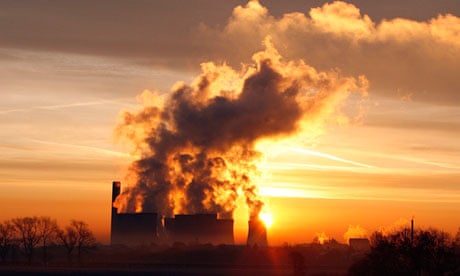Coal is enjoying a renaissance, with the highest consumption of the fuel since the late 1960s. The unexpected development threatens to put climate change targets out of reach – and much of the reason is the rise of a supposedly "green" fuel, natural gas.
The controversial use of shale gas in the US, where it now makes up a quarter of electricity generation, has brought down carbon emissions there – but the greenhouse gases have simply been exported elsewhere, meaning no net gain for the planet, research by the Guardian and other sources has found.
As gas power has replaced coal in the US, the excess coal has pushed down prices on world markets, sparking a bonanza for the high-carbon fuel. Last year, coal had its best year in more than four decades, according to the World Coal Association.
Its global share of primary energy consumption rose from about 25%, where it has been for years, to 30% – the highest level since 1969, long before governments made any efforts to tackle climate change.
Green campaigners are concerned by the findings. Guy Shrubsole, energy campaigner at Friends of the Earth, said: "This shows that if we want to avoid devastating climate change, we have to leave the fossil fuels in the ground, and go instead for clean energy sources." And Vinuta Gopal from Greenpeace said: " Coal is the fuel of the past not the future."
In the UK, between the second quarter of 2011 and the second quarter of 2012, coal consumption rose by nearly a quarter. Europe overall has burned more coal in the past year than any time since it pledged steep emissions cuts, and China and India have also been burning more. Cheap coal, caused by weakening demand in the US where power stations have switched fuels to use gas, has been the biggest factor.
The role of shale gas in this bonanza has been overlooked by supporters of the controversial fuel. In the US, which has pioneered the technology of fracking – whereby rocks are blasted apart under huge pressure to release natural gas – the resulting gas has been championed as a green fuel because it emits half the carbon of coal when burned.
Fracking has cut the US's greenhouse gas emissions to their lowest level since 1992, as power stations across the country have switched to gas from coal. That switch may even enable the US to meet its international climate change target of cutting emissions by 17% compared with 2005 levels, as agreed at the Copenhagen climate summit in 2009.
But if the use of gas in the US is bringing down emissions there, the opposite is the case elsewhere. Cheap coal has flooded Europe, driving up consumption.
A report from the Tyndall Centre for Climate Change Research, at the University of Manchester, published on Monday, found carbon dioxide emissions from domestic energy in the US fell by 8.6% from 2005, the equivalent of 1.4% per year. But more than half of the power sector emissions were displaced overseas by the trade in coal.
John Broderick, lead author on the Tyndall Centre report, said predictions of a golden age of gas created by fracking technology were misplaced. He warned: "We must seriously consider whether a so-called golden age would be little more than a gilded cage, locking us into a high-carbon future."
Chris Shearlock, sustainable development manager at the Co-operative, which commissioned the Tyndall Centre report, said: "The proponents of shale gas have always claimed that it is a lower carbon alternative to coal. However, this is only true if the coal it displaces remains in the ground and isn't just burnt elsewhere. Without a cap on global carbon emissions, shale gas is burnt in addition to other fossil fuels, increasing total emissions."
Another reason for the resurgence of coal in Europe has been the failure of the European Union's main climate change mechanism, the, to stop the rise in coal use. The price of carbon permits is extraordinarily low under the scheme, which was intended to penalise the burning of high-carbon fuels, forcing companies to use modern technologies and become more efficient. Low permit prices take away that incentive.
Paul Newman, managing director of ICAP Energy, a London brokerage, said: "With prices at 18-month lows, everyone feels a bit more inclined to use coal at the moment. [The low permit price] is encouraging people to shoulder shrug, and say "We'll just go ahead and use coal". That is the signal that the emissions market is giving off."
Coal is the highest carbon emitter of the major fossil fuels, and had been in long-term decline until last year, as governments around the world put in place goals to cut emissions and stave off the worst effects of global warming. Its return to favour – in Europe, in particular, which has some of the world's strongest regulations on greenhouse gases – could spell the end for any hopes of avoiding dangerous climate change. Scientists say emissions must peak within the next five years if the worst effects of global warming are to be avoided.
Consumption of coal has risen by 8.4% in developing countries, according to the International Energy Agency. Newman said: "Coal is the commodity of choice for those who want exposure to the electrification of the developing world."
Milton Catelin, chief executive of the World Coal Association, said coal use was likely to continue to increase, and could help to lift people out of poverty. He said the way to tackle climate change was to capture the carbon dioxide from power stations and store it permanently underground. But he pointed out that carbon capture and storage (CCS) technology was receiving less investment than other low-carbon technologies – the Global Subsidies Initiative has found that nuclear and renewable energy projects (excluding hydro-electricity) receive $45bn (£28bn) and $27bn in subsidies respectively each year. In comparison, since 2005, only $12.2bn had been made available in total to fund CCS demonstration. "That is serious underfunding," Catelin said.


Comments (…)
Sign in or create your Guardian account to join the discussion